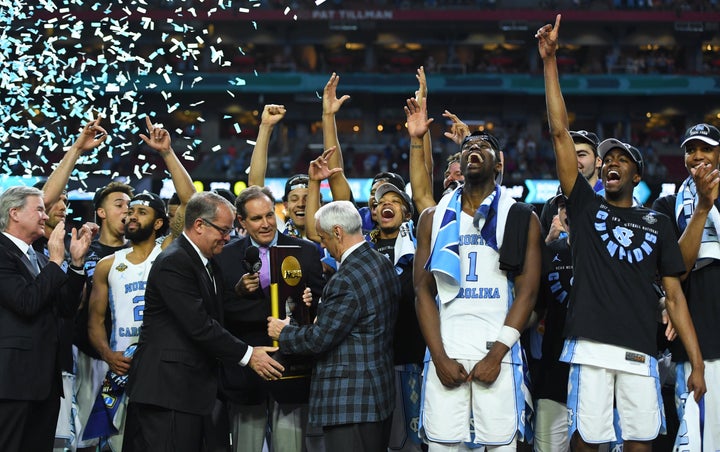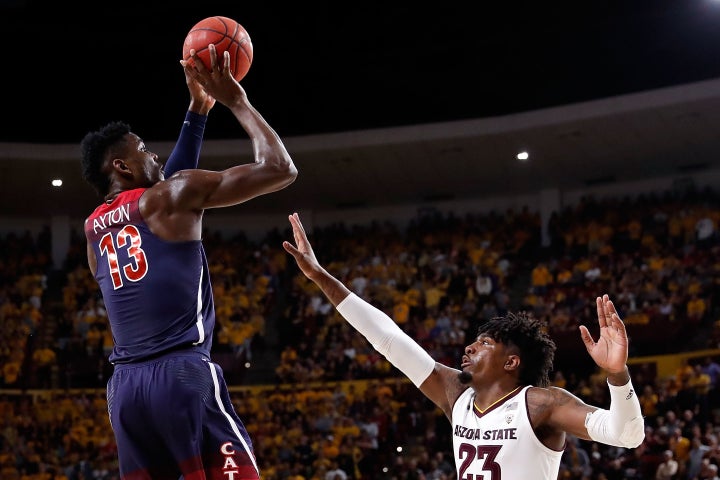
The annual basketball-and-brackets festival known as March Madness is just days away. From office pools to presidential predictions to the NCAA tournament itself, in the coming weeks the nation will become temporarily obsessed with nominally unpaid athletes and the names of the schools they wear on their jerseys.
I grew up in the thrall of the Big East’s Rollie Massimino, Lou Carneseca, Patrick Ewing and Pearl Washington. College basketball literally filled my dreams during my teenage years, and my waking hours were spent hooping and pretending that (A) I was about 7 or 8 inches taller or (B) I had a much better vertical and jump shot.
This year, however, I won’t be watching the tournament. I’m done with college sports as they’re currently constituted, which expect us to believe the falsehood that we’re cheering for a bunch of students who play sports in their spare time simply for the love of the game. This is as demeaning to fans as it is unfair to the players, who are kept from being justly compensated by the NCAA and its member institutions.
The NCAA has long profited from the labor of student athletes. In Division I basketball, these athletes are disproportionately African-American men and women who, depending on your point of view, are either unpaid or are paid handsomely with room, board, tuition and possibly a small stipend.
Historically, the NCAA has taken the position that amateurism is integral to the success and popularity of college athletics. It’s a position they’ve stubbornly maintained for decades, despite the fact the definition of “amateurism” has changed over the years whenever it suits the NCAA’s needs. Fans have demonstrated time and time again they are more than happy to support paid athletes; examples include not only the Olympics and professional sporting leagues but, if we’re honest, current Division I athletics as well.
“The NCAA farcically claims to limit athletes to 20 hours of athletic activity per week.”
Surely, if people were put off by the idea of paying college athletes, then Division III schools (which do not offer scholarships, let alone give their players stipends) would have the largest fan bases and Division I schools caught funneling money to their star players would lose fans in the wake of pay-for-play scandals. It’s hard to find a single example of this kind of backlash. As Jessica Luther so ably demonstrated in Unsportsmanlike Conduct: College Football and the Politics of Rape, the devotion that fans have for college teams allows universities to rationalize and excuse behavior much, much worse than taking money under the table from an agent or shoe company.
In this annual tale, the NCAA is often portrayed as the only villain; however, colleges and universities are not required to follow NCAA dictates. It’s the universities, not the NCAA, that control course curricula and how they treat their student athletes. Big-time college athletics have distorted the mission of universities for more than a century, as evidenced by the endless scandals that punctuate the seasons. Indeed, if change is going to come, it will surely have to come from the universities themselves, not from the NCAA.
Schools will protest they don’t have enough money to pay student athletes. This is certainly true. A 2014 NCAA study of Division I athletic department finances showed only 20 of the 1,083 college sports programs in the nation are profitable. Even among the highest subcategory of colleges ― those eligible to compete in annual football bowl games ― 83.7 percent lost money, with a median loss of $14.9 million dollars. The difference is made up from the tuition dollars and fees that are charged to the university student body at large. Despite millions in revenue, the expenses associated with D-I level competition ― including coaches’ salaries and chartered airplanes ― leave the vast majority of athletic budgets deeply in the red. But the mismanagement of millions of revenue dollars doesn’t explain why colleges and the NCAA are opposed to athletes making money on their own through endorsements, contracts with agents or personal appearance fees, as in the case of Olympic athletes.
According to a recent FBI report, University of Arizona Coach Sean Miller was caught on tape discussing a $100,000 payment as a de facto signing bonus for top recruit Deandre Ayton. If true, this transaction is a problem only because it is against the NCAA’s rules, not because being paid for one’s talent or excellence is inherently immoral. If the rules changed and athletes were allowed to receive pay for their services, everyone would be better off. Schools could compete honestly for the nation’s best talent. Athletes would be fairly compensated alongside their coaches.

To those who argue these athletes are unpaid amateurs, then I say: Pay them. To those who say they are already being paid, then I’m glad to agree that we’re not talking about a line between moral and immoral and instead are just negotiating a price.
As ESPN personality and longtime advocate for NCAA reform Jay Bilas has often pointed out, the whole world runs on mutually beneficial, contracted obligations, so why not college sports? We live in a market economy; let’s allow the market to set the price for these athletes’ services. No one is arguing colleges should be required to pay their athletes, and schools or conferences that want to adopt a pay-for-play model with athlete salaries could compete in a Premier Division above Divisions I, II and III. Networks would surely line up with bundles of cash to broadcast these games.
I’ve taught a fair number of D-I athletes in my career as a professor. Some are the platonic ideal of what we hope for when we say “student athlete.” Anecdotally, these are more often than not either women or men in non-revenue sports. My classroom experience with football and male basketball players has been less heartening. Despite the incredible odds stacked against ever going pro, their focus is overwhelmingly on their sport, with academics not infrequently reduced to a obstacle to be overcome to retain eligibility.
One creative solution we see proposed from time to time is to give intercollegiate athletes academic credit for their sports. Universities around the country allow artists, dancers and musicians to major in a physical activity, so why not basketball and football players? And if they aren’t allowed to major in their respective sports, athletes should be allowed to enroll in an interdisciplinary sports studies program. Such majors exist at many institutions big and small, but no one has yet taken the logical next step to recognize the educational worth of playing an intercollegiate sport.
“If the rules changed, and athletes were allowed to receive pay for their services, everyone would be better off.”
Universities give credit (and charge tuition, at that) for, say, engineering students who take internships, because it’s clear that working in an office teaches future engineers useful things that can’t be taught in a classroom. The playing field is no different. A sports studies major that combined credit for a student’s athletic efforts with historical and sociological examinations of sport, sports management, journalism, communications, exercise science and coaching would not fix all of college athletics’ ills, but it would serve as an important initiative ― especially if coupled with compensation reform for revenue sports.
The NCAA farcically claims to limit athletes to 20 hours of athletic activity per week. If this bore any relationship to reality, it would allow the athletes to also be true, full-time students. However, that 20-hours-per-week mandate doesn’t include traveling to and from games, weight lifting, training room activities, mandatory study halls and tutoring, compliance meetings, training table meals, hosting recruits, getting to and from practice, pre-practice activities, or post-practice showering and recovery. These loopholes can quickly turn 20 hours a week into a 50-hour weekly commitment.
Offering credit for student athletes’ on-field work would reduce the number of in-classroom courses they enroll in each semester ― and allow them to better focus on those courses, as well. It would do much more to fulfill a university’s academic mission than the status quo. Currently, the pressure to keep players eligible in pursuit of victory’s spoils has perverted the academic mission of many colleges. Even otherwise elite schools, such as the University of North Carolina, have been revealed to be shepherding significant numbers of athletes through dummy courses and awarding them useless and fraudulent degrees.
The suggestions when it comes to reforming big-time college sports are endless, and almost any alternative would make more sense than the current NCAA system, which asks spectators to believe something that is self-evidently untrue: that elite Division I athletes are just regular students who happen to play a sport. It’s time to abandon the fanciful conceits that athletes devoting 50 hours a week to their sports are also able to fully devote themselves to being students ― and that amateurism is morally superior to fair compensation and transparent contractual relationships.
Patrick F. McDevitt is an associate professor of history at State University of New York at Buffalo.
